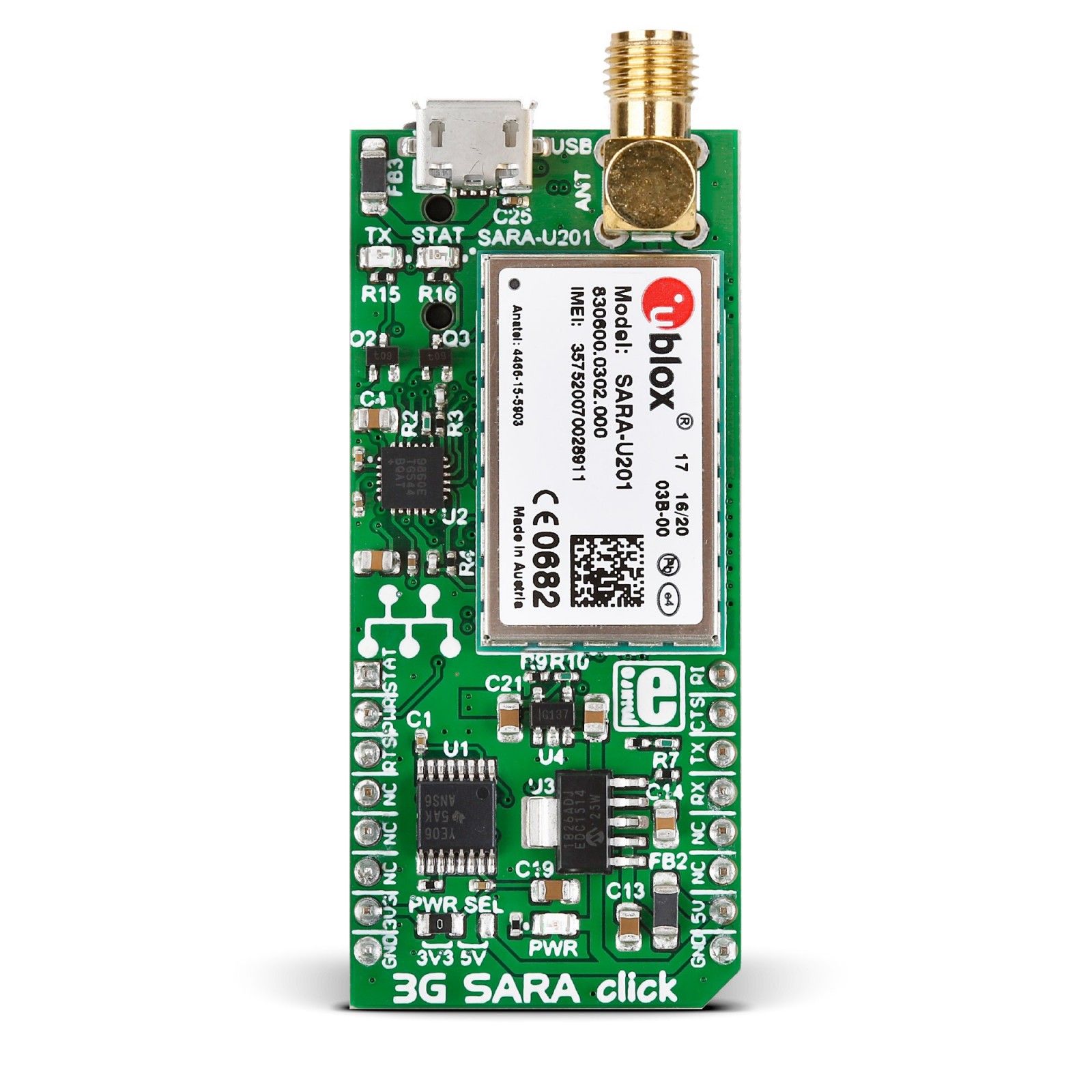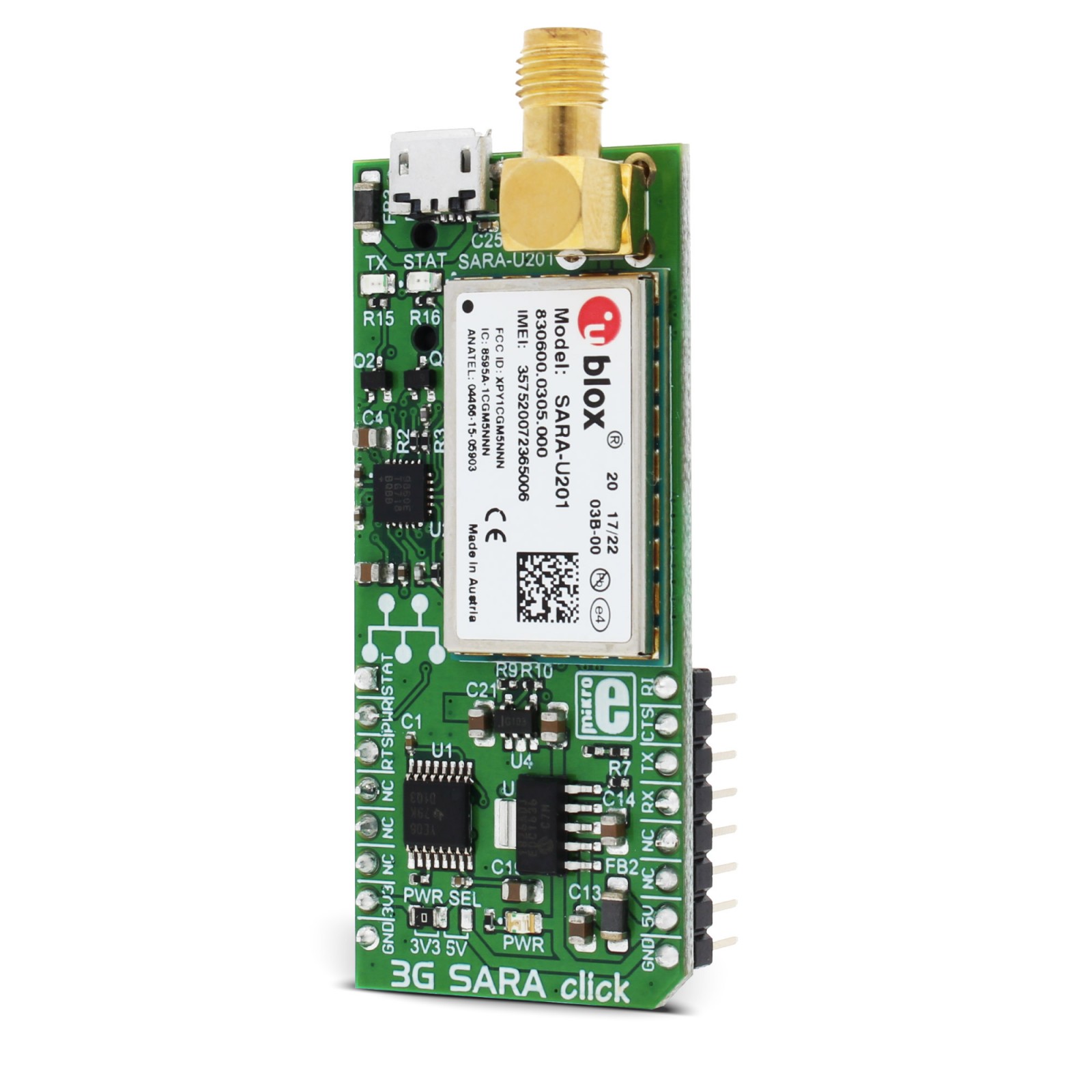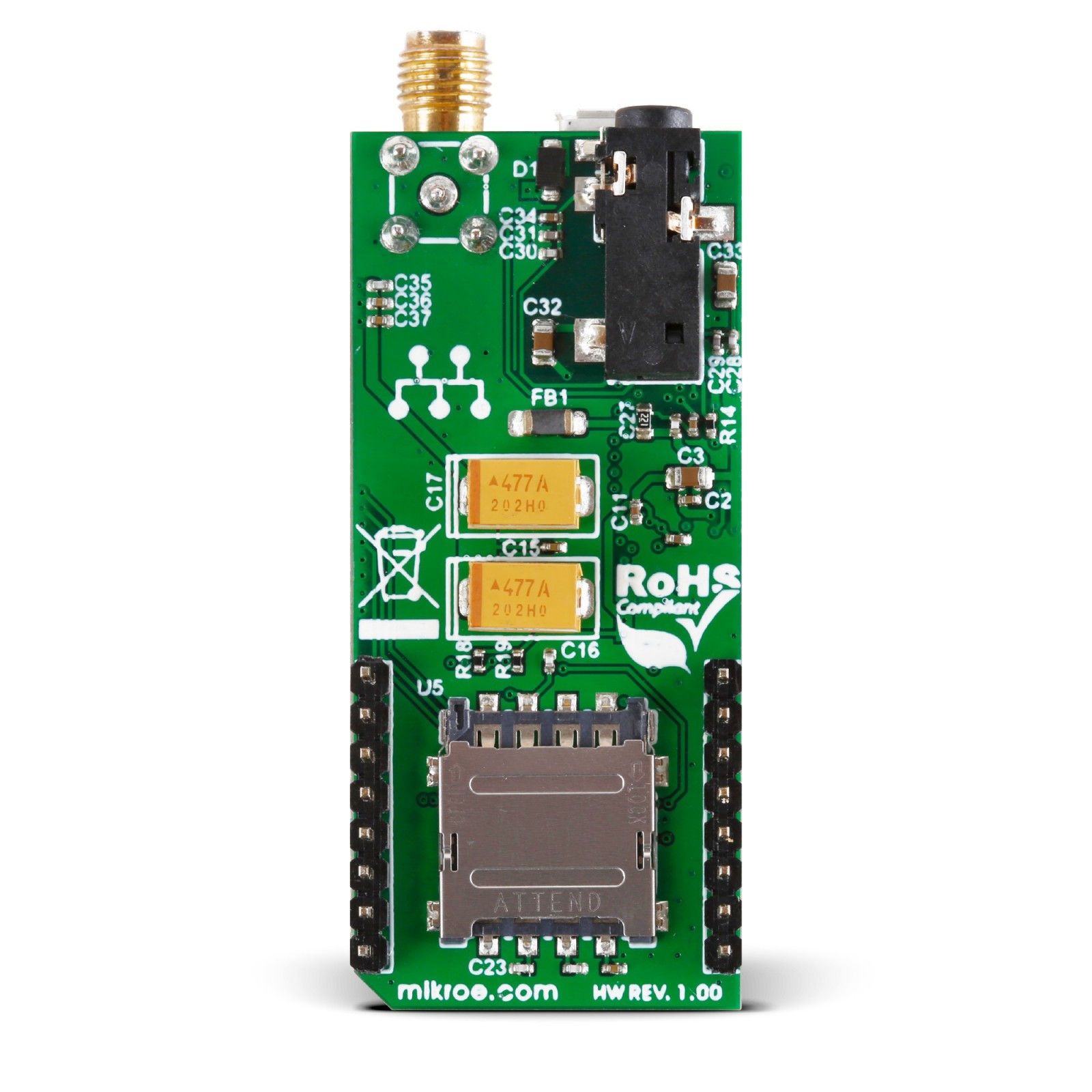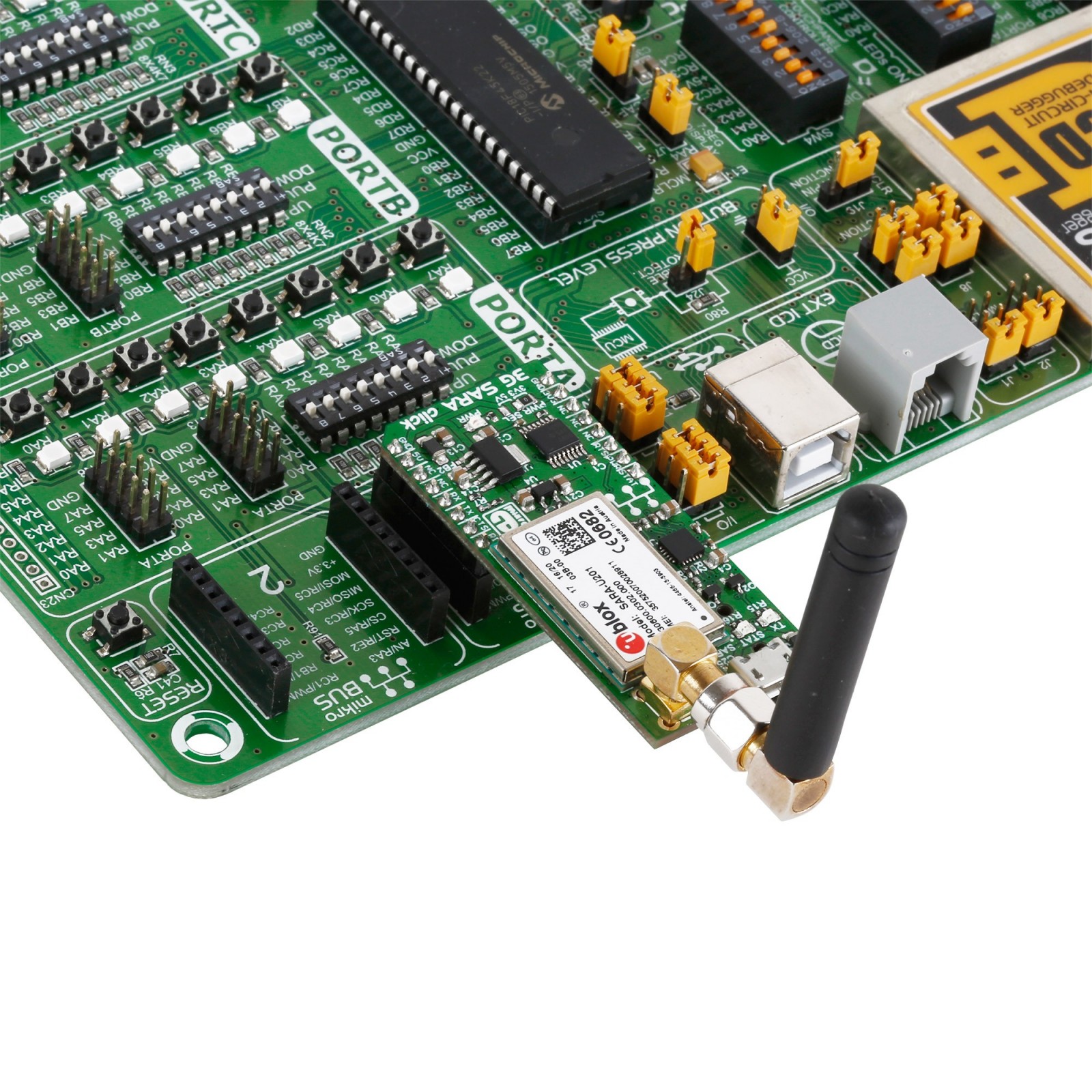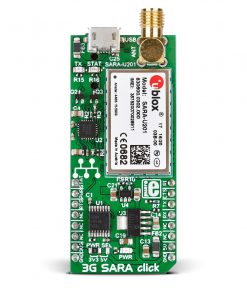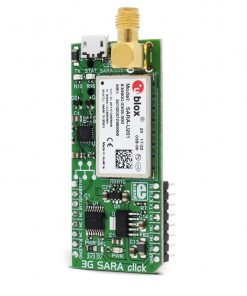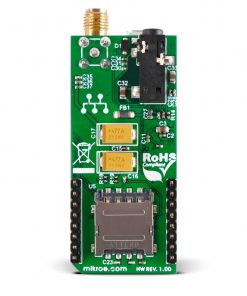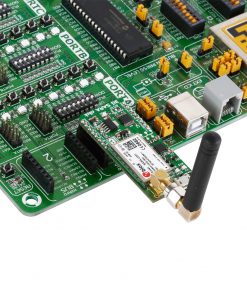3G SARA Click
R2,200.00 ex. VAT
3G SARA Click is a compact add-on board representing a versatile cellular network communication solution. This board features the SARA-U201, a 3.75G HSPA cellular module from u-blox. This module includes a full set of options for cellular networking and communication, such as the network indication, full embedded TCP/UDP stack, HTTP and HTTPS transfer protocols, IPv4/IPv6 dual-stack support, antenna detection, jamming signal detection, and more. 3G SARA Click also features the HSPA data rates of 7.2 Mb/s (downlink) and 5.76 Mb/s (uplink), as well as the ability to maintain the voice call during the data transfer (3G). Onboard 16-bit audio CODEC IC adds high-quality voice communication capability. This Click board™ makes the perfect solution for mobile internet terminals, automatic meter reading, remote monitoring and control, surveillance and security, and similar applications that rely on a cellular network connection.
3G SARA Click is supported by a mikroSDK compliant library, which includes functions that simplify software development. This Click board™ comes as a fully tested product, ready to be used on a system equipped with the mikroBUS™ socket.
Stock: Lead-time applicable.
| 5+ | R2,090.00 |
| 10+ | R1,980.00 |
| 15+ | R1,870.00 |
| 20+ | R1,799.60 |
How does it work?
3G SARA Click is based on the SARA-U201, a 3.75G HSPA cellular module from u-blox. The SARA U-201 module can be used worldwide, where a complete list of frequencies and other relevant info about the module itself can be found in the attached SARA-U201 datasheet. This device is the main component of the Click board™, consisting of several internal blocks or sections, such as the antenna switching section, RF transceiver section, memory, power management, and most importantly – the cellular baseband processor. This section contains the logic necessary for managing the other sections and provides the interface to the host MCU. This interface consists of several lines that report the antenna status, sim card status, SIM card interface lines, GPIOs, UART interface lines, USB interface lines, I2C bus lines, device control lines, and I2S bus lines.
The SARA-U201 module has to be powered by a clean and stable power supply. The voltage needed for the module to work properly is about 4V, and it is derived from the 5V mikroBUS™ rail through the MCP1826, a 1A LDO regulator from Microchip. Although the SARA U-201 is a low-power device, the cellular network modules, in general, are notorious for their high-power consumption, so this LDO had to be used.
Digital sections of the SARA-U201 are internally supplied by 1.8V, so it is necessary to condition the communication bus lines which connect the host MCU with the module. For this reason, another small LDO is used, providing a needed reference voltage for one side of the TXB0106, a 6-bit bidirectional level shifting and voltage translator with automatic direction sensing from Texas Instruments. The reference voltage for the other side of the level shifter is taken from the onboard SMD jumper, labeled as PWR SEL. This jumper selects between 3.3V and 5V from the mikroBUS™, depending on the used MCU type and its logic voltage level requirements.
The UART bus of the SARA-U201 module is connected to one side of the level shifter, while the other side (shifted) is connected to the respective mikroBUS™ UART pins. However, the SARA-U201 module is designed as the traditional DCE device (Data Communication Equipment), offering the full UART pin count, including the hardware flow control pins. These pins are routed to the mikroBUS™ pins RTS and CTS and can be used in the MCU software if the hardware flow control is needed. The ringing indicator is routed to the mikroBUS™ RI pin.
The network connection status pin is routed to both the mikroBUS™ STAT pin through the level shifter and the yellow LED used to indicate the network connection status visually. The transmitting status is indicated by the red TX LED next to the STAT LED. The network status is indicated by the STAT pin and the STAT LED by six patterns. The PWRKEY pin is routed to the mikroBUS™ PWR pin and used during the power-up sequence. A low pulse on this pin will power the device if a valid supply voltage is provided. To properly detach from the network and store the working parameters in its non-volatile memory, the module should be safely powered off either by issuing the AT+CPWROFF command or by a low pulse on the PWRKEY pin for at least 1 second before disconnecting the power source.
As mentioned, SARA-U201 offers the I2S interface, mainly used for digital audio. The MAX9860, a 16-bit mono audio voice CODEC IC from Analog Devices, provides the 3G SARA Click with voice communication. This IC uses the I2S and I2C interfaces to communicate with the SARA-U201 module. It is also powered with 1.8V from the LDO, so no level shifting is required. This IC provides a clean and audible analog interface for connecting the headset, with one audio output channel and one microphone input channel. The headset can be connected via the onboard 3.5mm audio jack.
SARA 3G Click is also equipped with a micro USB connector. It allows the module to be powered and configured by a personal computer (PC). The u-blox company offers a software suite that can be used to configure the SARA U-201 module. The u-blox’s m-center is a free evaluation software for all their cellular modules. It has an easy-to-use graphical interface and can be used to configure the module and save changes to the EPROM. Viewing and editing SIM directory entries, sending text messages, and communicating with the wireless module using AT commands are possible. The Micro SIM card holder on the back of the Click board™ is used to install a SIM card. This device can’t be used without a valid SIM card, which allows connection to the cellular network. Both 1.8V and 3V SIM card types are supported.
This Click board™ can operate with either 3.3V or 5V logic voltage levels selected via the PWR SEL jumper. This way, both 3.3V and 5V capable MCUs can use the communication lines properly. However, the Click board™ comes equipped with a library containing easy-to-use functions and an example code that can be used, as a reference, for further development.
Specifications
Type
3G UMTS,GSM/LTE
Applications
It can be used for the mobile internet terminals, automatic meter reading, remote monitoring and control, Surveillance and security, and similar applications, that rely on a cellular network connection
On-board modules
SARA U-201, a 3.75G UMTS/HSPA cellular network module from u-blox, MCP1826, a 1A low drop output (LDO) regulator from Microchip, TXB0106, a 6bit bidirectional level shifter from Texas Instruments
Key Features
It features a full set of options for the 3.75G cellular networking and communication, integrated SIM card holder, SMA antenna connector, micro USB connector for interfacing with the PC, onboard high quality audio CODEC…
Interface
UART,USB
Feature
No ClickID
Compatibility
mikroBUS™
Click board size
L (57.15 x 25.4 mm)
Input Voltage
3.3V or 5V
Pinout diagram
This table shows how the pinout on 3G SARA click corresponds to the pinout on the mikroBUS™ socket (the latter shown in the two middle columns).
Onboard settings and indicators
| Label | Name | Default | Description |
|---|---|---|---|
| – | PWR | – | Power LED Indicator |
| – | TX | – | Transmission LED Indicator |
| – | STAT | – | Network Connection Status LED Indicator |
| JP1 | PWR SEL | Left | Logic Level Voltage Selection 3V3/5V: Left position 3V3, Right position 5V |
3G SARA Click electrical specifications
| Description | Min | Typ | Max | Unit |
|---|---|---|---|---|
| Supply Voltage | 3.3 | – | 5 | V |
| Frequency Range 3G/2G | 800/850 | – | 2100/1900 | MHz |
| Data Rate 3G/2G | 384/85.6 | – | 7200/236.8 | kbps |
Software Support
We provide a library for the 3G SARA Click as well as a demo application (example), developed using MIKROE compilers. The demo can run on all the main MIKROE development boards.
Package can be downloaded/installed directly from NECTO Studio Package Manager (recommended), downloaded from our LibStock™ or found on Mikroe github account.
Library Description
This library contains API for 3G SARA Click driver.
Key functions
-
Power module.
-
Send command.
Example Description
This example reads and processes data from 3G SARA clicks.
void application_task ( void )
{
c3gsara_process( );
if ( send_data_cnt == 5 )
{
c3gsara_send_command( &c3gsara, C3GSARA_ATH_COMMAND );
c3gsara_process( );
send_data_cnt = 0;
}
else
{
send_data_cnt++;
}
}
The full application code, and ready to use projects can be installed directly from NECTO Studio Package Manager (recommended), downloaded from our LibStock™ or found on Mikroe github account.
Other Mikroe Libraries used in the example:
- MikroSDK.Board
- MikroSDK.Log
- Click.3gSara
Additional notes and informations
Depending on the development board you are using, you may need USB UART click, USB UART 2 Click or RS232 Click to connect to your PC, for development systems with no UART to USB interface available on the board. UART terminal is available in all MIKROE compilers.
mikroSDK
This Click board™ is supported with mikroSDK – MIKROE Software Development Kit. To ensure proper operation of mikroSDK compliant Click board™ demo applications, mikroSDK should be downloaded from the LibStock and installed for the compiler you are using.
For more information about mikroSDK, visit the official page.
Resources
Downloads
| Weight | 25 g |
|---|---|
| Brand | MikroElektronika |

